How to sketch well?
Sketch often
Painting is art and culture as well as a type of skill. All skills follow the convention that “practice makes perfection”. Without practice, how can you become good at something? Diligence and training may be old-school but that doesn’t mean they do not work.
In the traditional opera community, they often say: “Martial arts must be practiced constantly and songs must be sung frequently”. Diligent practice is therefore the key. What about diligent practice without giving it proper thought? That does not work either. As Confucius once said: “Knowledge without thought leads to confusion, thought without knowledge leads to danger”. If we are curious and respectful of the lives that we try to capture, if we can then practice diligently and think constantly about improvements, we will naturally get better.
怎麼樣畫好速寫呢?
多畫
畫畫是藝術是文化,也是一種技藝,凡技藝就合‘熟能生巧’的常規,不熟哪來的巧呢?勤學苦練四字是老生常談,但是仍然是管用的。
傳統戲曲界流行‘拳不離手、曲不離口’,說的就是要勤練。光勤不動腦筋行不行呢?也不行,所以孔子早說了:「學而不思則罔,思而不學則殆」,有不少人畫了一輩子,數量也很多,不能說不勤,但是,腦袋躺著了,又是孔子提醒我們:心之官則思。腦子是用來思考的啊!如果我們對描寫的生命有一分好奇心、有一分虔誠,再加勤學苦練多動腦筋,哪有畫不好的呢?
Sketch Slowly
Is faster the better in sketching? Not always! I’ve seen many private studios in the West, Hong Kong and Taiwan where the time allowed for nude sketches is so short that the paintings come out looking like wild scrawls. Many people spend years sketching in studios and make little progress. As they made no improvement, they decide that they simply don’t have the talent. Talent may of course be a factor but I think that in most cases they were going too fast. As they say, “nine of ten accidents are due to speeding” so my advice is: If you want to sketch well, “sketch slowly”. First, try to get the proportions right, capture the key features and make everything as simple as possible. Slowing down will avoid misshapen proportions and too much detail. Sketching should be relatively fast but is not all about speed. Start slow, then gradually speed up.
速寫要慢
畫速寫是否愈快愈好呢?也不盡然,我看歐美、港、台有些民間畫室的人體速寫,常常因為時間太短而使得不少畫作像是鬼畫桃符、荒腔走板。很多人經年累月地跑畫室畫速寫,畫了半輩子,還是老樣子,不進步就怪自己沒天分,或許與天分有點關係吧,我看絕大多數的問題是太快!所謂“十次肇事九次快”,我倒建議:要畫好速寫,先畫“慢寫”,先學會抓住形體比例和特徵的方法以及刪繁就簡概括對象的規律。只有先慢一點才不會比例失據,概括無方。速寫練習,相對快就好,絕對不要一味求快,要由慢到快。
Start with a draft, using pale, light lines to define the areas, proportions, dynamics and trends before putting pencil to paper. Do not draw any details at this point. Once the draft is ready, work outwards from the key parts such as the head and hands.
可以起稿,在下筆之先用淡而輕的線條定範圍、定比例、定動態和趨勢,在此步驟時千萬別畫細節,定了之後再從主要之處如頭部和手部畫開去。
Angular rather than curved lines
Sketches can be a little angular like Vrubel or be a little more curvaceous like Menzel. If you are new to sketching however, using more straight lines will make capturing relative proportions and dynamics easier. This technique is often used at the Soviet Academy of Arts during sketching classes. Straight lines may seem a little less sophisticated but the main features and proportions will remain true. Curved lines may seem more lively but can run wild like a mustang in unskilled hands.
先方後圓
速寫可畫得方一點,如俄國的符魯別爾,也可如門采爾,曲線多一些。但是,開始接觸速寫直線用多一點便於抓對比例和動態。這是蘇聯美術學院課堂速寫中常用的方法。直線看似笨一點,但造型的特徵、比例不會跑掉,曲線看似活潑一些,但未熟練時如脫疆野馬,漫無邊際。
Use lines more
When you start practicing sketching, avoid adding value. Dispense with backgrounds altogether as well. With lines, what matters is the edges of shapes. Get this right then the rest can be ignored or reduced.
要多用線條
開始練習速寫時,不用或少用明暗、深淺,更不要畫什麼背景。所謂的線,最重要的當然是形體的邊沿線,這個畫對了其他可以省去或減少。
Value
In sketching, value have a rhythm of their own:
- Value should be used where it can convey volume and height differences.
- Use for key features such as the head and hands.
- Use value for clothing texture.
- Use value for large blocks of black, gray and white.
- Use value to convey the texture of the subject.
- Use value where it can create strokes like Chinese paintings.
深淺有致
速寫中如果用到深淺也有點規律的:
- 深淺放在能表現體積和起伏之處。
- 放在頭部、手部等主要刻劃部位。
- 深淺放在衣紋等處。
- 深淺放在分別黑、灰、白的大區塊。
- 深淺放在表現對象物的質感處。
- 深淺放在能造成如中國畫中的筆墨趣味之處等等。
Rely on memory
When sketching, observe the subject as a whole. Don’t approach the subject too closely to avoid distorting the perspective. Slightly narrow your eyes when observing and do not fix on a point. Don’t glance up at the subject with every line. You should instead, draw a small area for each glance. This is a process of rapid observation and memorization. In other words, half of the work in sketching depends on memory. This is a part of the sketching technique and also what makes it click. Many people don’t understand this so they look up with every stroke and still haven’t mastered sketching after a lifetime of trying.
要靠記憶
速寫也要整體觀察,與描繪對象距離不要太近,以防透視太大比例失調。觀察時眼微瞇,不要盯著一點看,畫速寫並不是看一筆畫一筆,而是看一眼畫一片,是一種迅速觀察,馬上記憶的過程,可以說,畫速寫一半是靠記憶,這是畫速寫的方法,也可說是訣竅,很多人不了解,總以為是看一眼畫一筆,結果一輩子還是不會畫速寫。
Drawing training is fundamental
High quality sketches require a certain level of drawing ability and knowledge of the anatomy. A solid foundation in drawing is required to produce sophisticated figure sketches because every line and stroke in sketching is based upon the shape and textures of the form. It must also be supported by artistic sophistication.
素描是基礎
速寫要精妙,一定要有素描能力和解剖知識作基礎。要畫好有看頭的人物速寫還非要有一定的素描基礎不可,因為,速寫中的一線一劃,一勾一抹,都以描寫形體的起伏、質感為內涵,也要有藝術修養作支撐。
Study anatomy
It is very important to understand the growth patterns of the human skeleton and muscles as well as the lengths and relative proportions of key body parts. For the skeleton and muscle, draw from books on anatomy while copying and memorizing the names of each part. This is the only way to understand the details and create lifelike drawings.
要研究解剖
了解人體骨骼和肌肉的生長規律,對人體各主要部位的長短、大小比例有明確的了解和記憶是非常重要的。人體主要骨骼和肌肉要對著解剖書臨摹,要將名稱抄寫下來,死背、背熟。非如此,不得精妙,非如此,不得動人。以我的觀察,不少缺乏素描能力和解剖知識的人物速寫非但是嬌柔做作、虛有其表,甚至是裝腔作勢、‘胡言亂語’。
Sketches are art works in their own right
In the past, sketches were used to record everyday images and also as drafts. Advances in technology and the availability of photographic equipment meant that this recording function has almost been replaced completely. Sketching however does not reproduce an object completely. It is a highly sophisticated and inclusive form of drawing that has its own artistic merits. When we look at the most representative sketches of the great masters, we find that they were just as memorable as the masterpieces! In classical literature, the Yuan Dynasty xiaolingand Tang Dynasty quatrains all had a timeless and minimalist sense of beauty. Like them, sketches are “exquisite poetry” that can be appreciated in their own right. The emergence and proliferation of cameras have in fact reinforced the irreplaceable nature of sketching due to its ability to condense and reflect the creator’s personal ability, aesthetic experience and personality.
速寫是有獨立欣賞價值的繪畫
速寫畫在早期有記錄生活形象的作用,也有創作草稿的功能。隨著科學的發展、攝影器材的普及,這種形象記錄的作用幾乎被完全取代。但是,速寫有別於照片對物象的完全複製,它是高度概括、高度簡練的描繪手段下的繪畫,有獨立的藝術品性質。我們發現世界上傑出的大師之代表性速寫與他們的主題性作品幾乎同樣令人印象深刻、回味無窮!有如我們古典文學中元曲之小令,唐詩中的絕句一樣,有著隽永、簡潔的美感,速寫絕對是可以獨立欣賞的“絕妙好詞”。正由於照相機的出現與濫觴,愈是凸顯了速寫的無可取代,她對作者的自有能力、美感經驗和個人性格都是高度集中的反射。當人們發現照片油畫的軟弱無能後,一定會將微笑投給速寫。
Sketching is a chronology of life
For a diligent practitioner, sketching is like a chronology. Repin is reputed to have more than twenty boxes filled with sketches! Unfortunately, one of his daughters sold most of it in Eastern Europe during World War I so nothing has been heard of them for the last seventy or eighty years. I don’t have many sketches and I still sketch on and off to this very day. The early sketches were lost during the Cultural Revolution and while I treasure my later sketches, few are satisfying. To me however, each drawing represents my friends and relatives in those years and the people I met in those times… Whenever I open my old folios, my thoughts fly back to those bygone years. The people and events recorded in these sketches are therefore a record of my own life. To me, these “images” feel far more direct than written records and are taken far more to heart.
速寫是人生的編年史
對一個勤於畫速寫的人來說速寫有如一部編年史。列賓的速寫據傳就有20多箱!好像是他的一位女兒在第一次世界大戰時期將其中大部分賣到東歐去了,七、八十年來一直沒有下落,令人婉惜!我的速寫不多,斷斷續續也還在畫,早期的在文化革命時失落了,後來的速寫我自然很珍惜,雖然有可看性的很少,但是對於我自己,每張畫都記錄了那些年身邊的親友、或什麼因緣接觸到的時代人物,一打開舊畫夾……思絮就回到那永遠回不來的時光,記錄這些人和物也就是記述了我自己的生命歷程,這一幅幅的‘影像’比文字記錄來得更直接,更使自己感動。
This post is adapted from the forward from the Sketching Handbook. For more information about the book, please click here.
For more information about online drawing course, please click here.

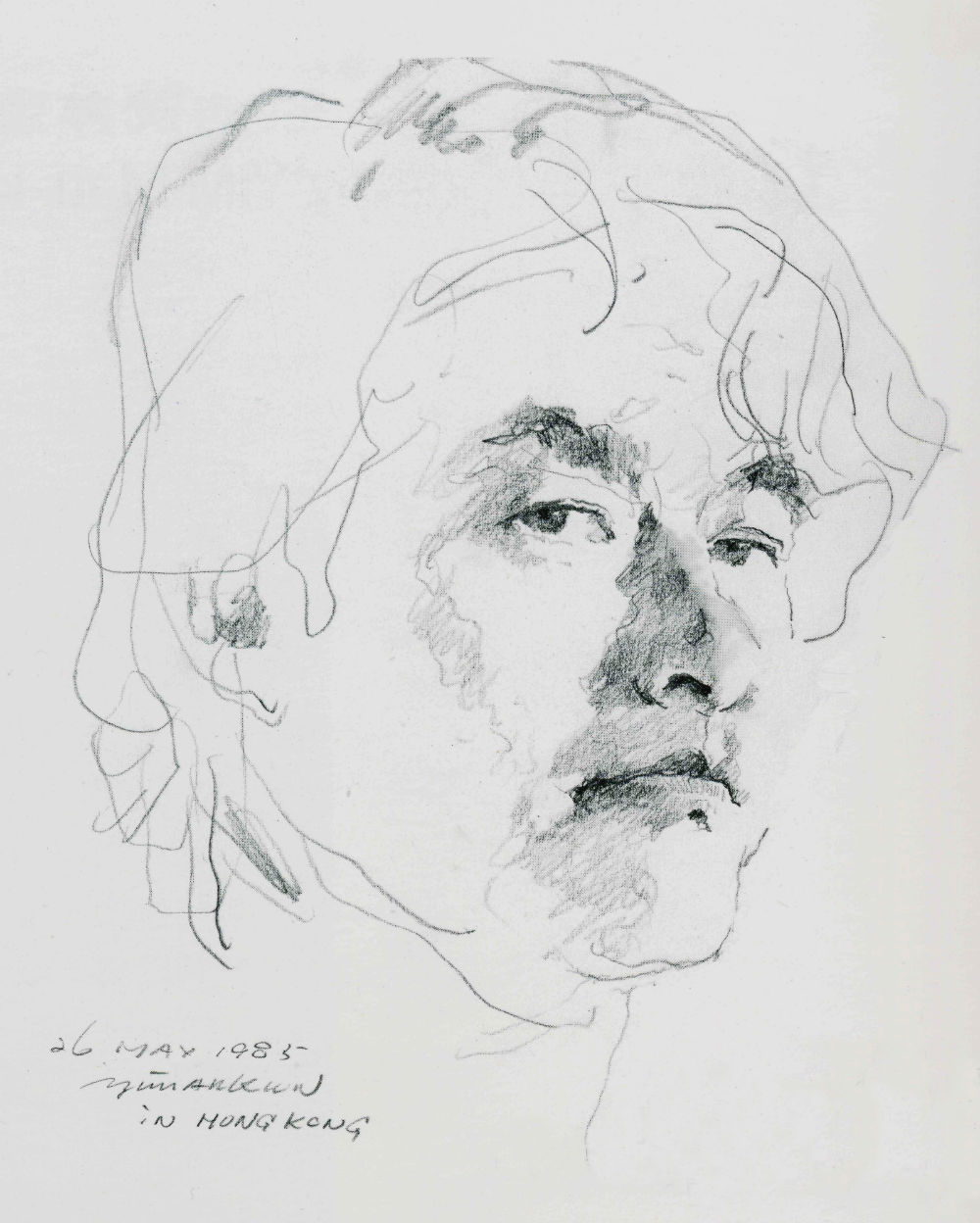
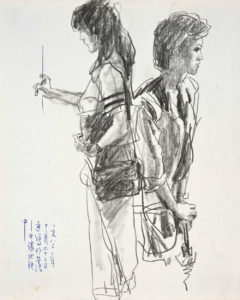
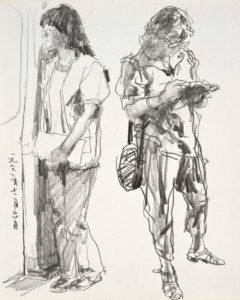
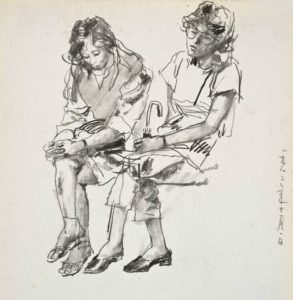
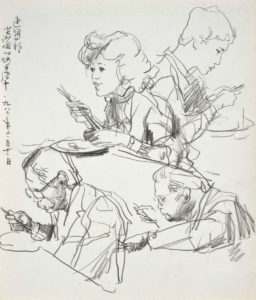
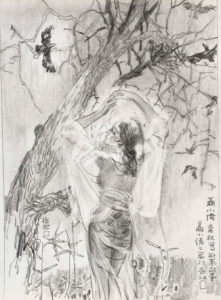
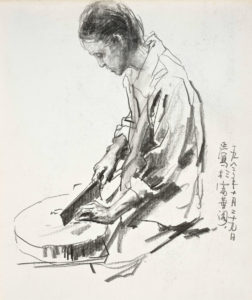

I do many sketches, but I took a lot from the lesson and will continue Thanks
Thank you,I learn a lot and glad to continue,,i wai new lessons.